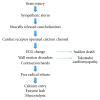A Review of Neurogenic Stunned Myocardium
- PMID: 28875040
- PMCID: PMC5569748
- DOI: 10.1155/2017/5842182
A Review of Neurogenic Stunned Myocardium
Abstract
Neurologic stunned myocardium (NSM) is a phenomenon where neurologic events give rise to cardiac abnormalities. Neurologic events like stroke and seizures cause sympathetic storm and autonomic dysregulation that result in myocardial injury. The clinical presentation can involve troponin elevation, left ventricular dysfunction, and ECG changes. These findings are similar to Takotsubo cardiomyopathy and acute coronary syndrome. It is difficult to distinguish NSM from acute coronary syndrome based on clinical presentation alone. Because of this difficulty, a patient with NSM who is at high risk for coronary heart disease may undergo cardiac catheterization to rule out coronary artery disease. The objective of this review of literature is to enhance physician's awareness of NSM and its features to help tailor management according to the patient's clinical profile.
Figures
References
Publication types
LinkOut - more resources
Full Text Sources
Other Literature Sources
Medical



